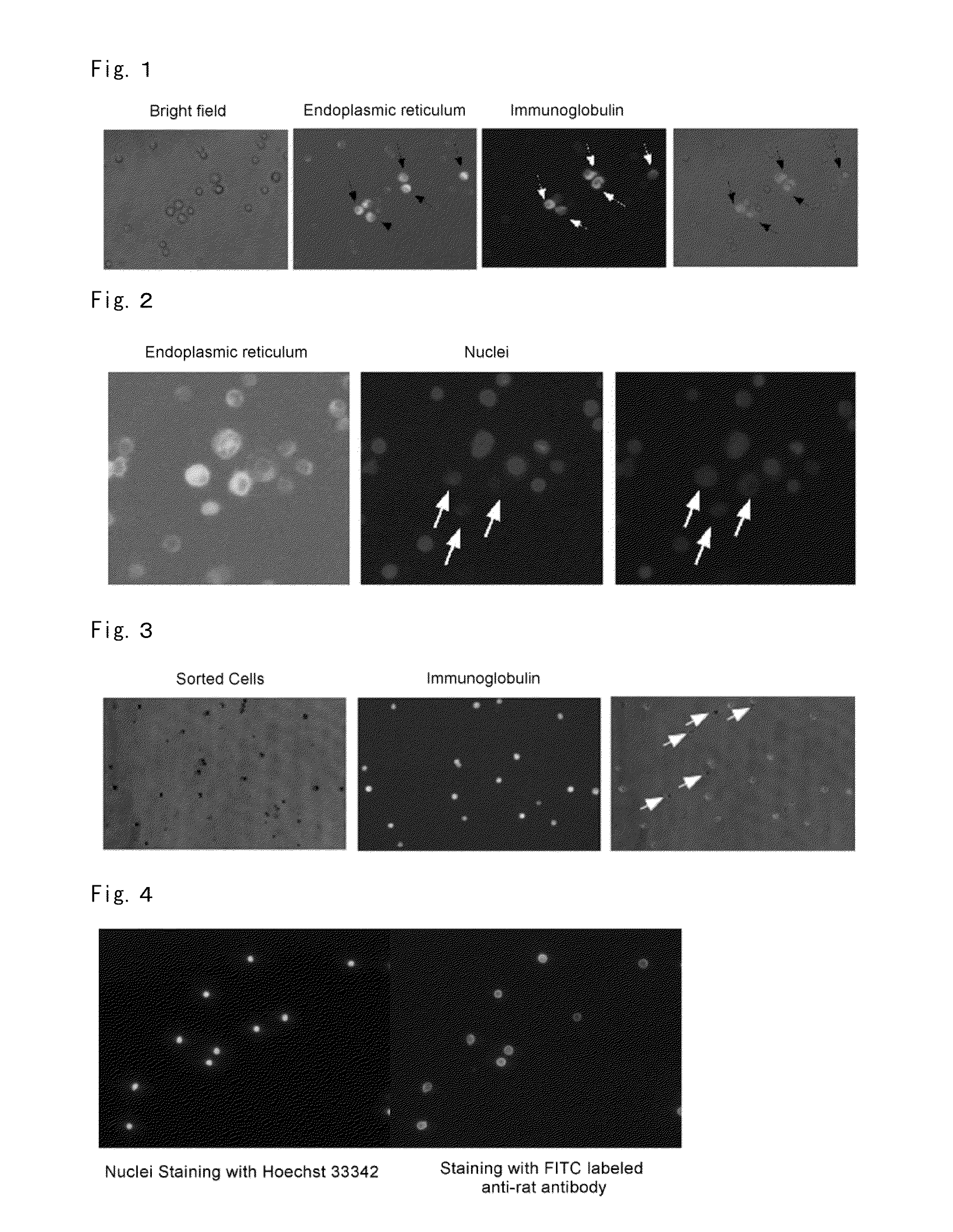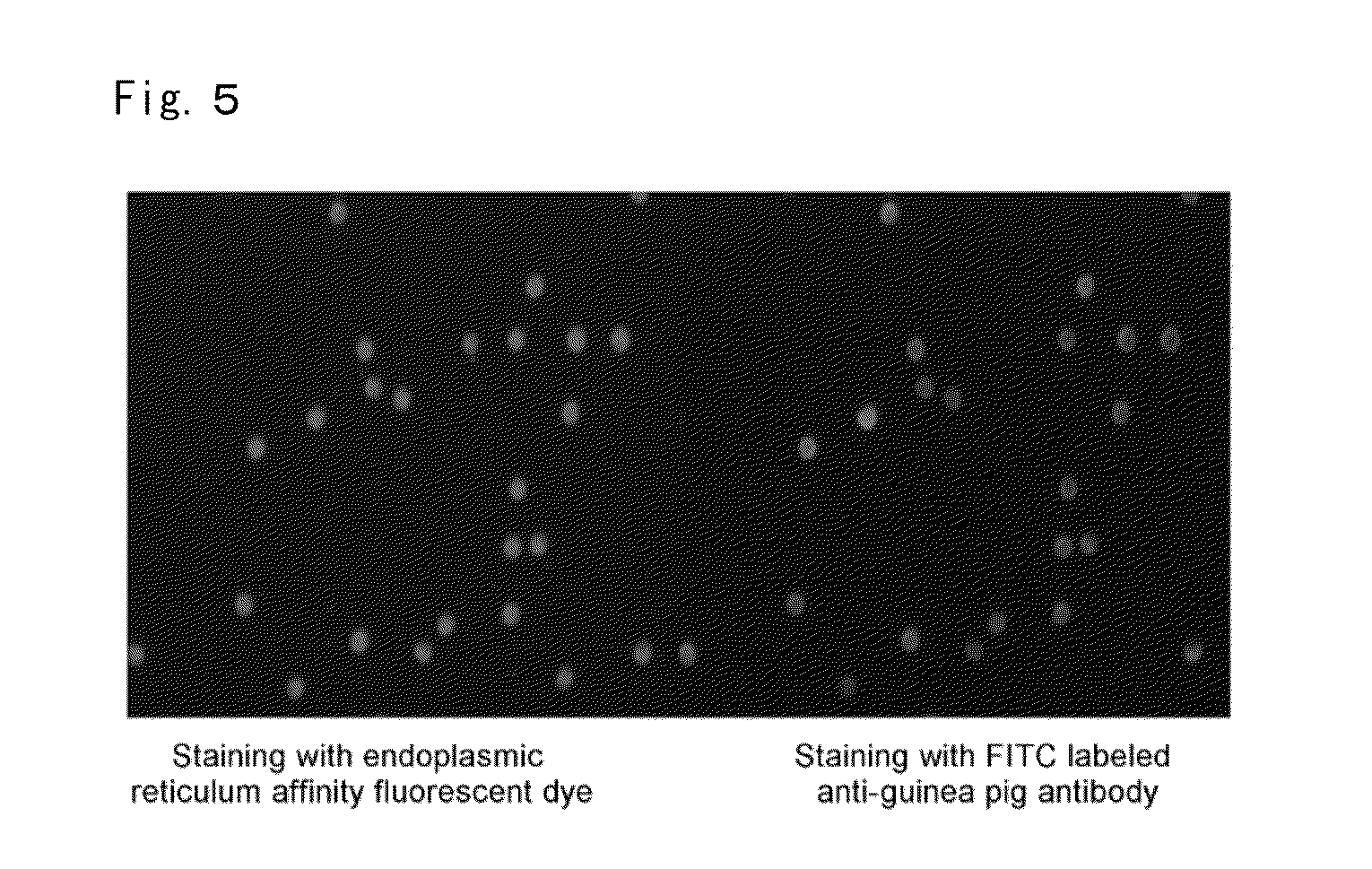Fluorescent probe for plasma cell identification and isolation, and plasma cell identification or isolation method using the probe
- Summary
- Abstract
- Description
- Claims
- Application Information
AI Technical Summary
Benefits of technology
Problems solved by technology
Method used
Image
Examples
example 1
Identification of Plasma Cells and Plasmablasts by Using Fluorescent Proves Staining Endoplasmic Reticulum
[0082]The cell group, which was CD49b negative, CD45R negative and CD138 positive, was obtained from the GFP immunized mouse lymph node according to the method described in the experimental method 1. These cells were stained with ER-Tracker (registered trademark) Blue-White DPX / lipid, and were subject to the fluorescence microscope observation. The result is shown in the FIG. 1. About 20% of cells emitted strong fluorescence with this probe, and these cells had the strongly stained area of the developed endoplasmic reticulum throughout cellular cytoplasm. Most of the remaining cells emitted weak fluorescence, and these cells had cell membrane area and small size of endoplasmic reticulum both of which were weakly stained. The fluorescent intensity ratio of cells emitting strong fluorescence to the remaining cells emitting weak fluorescence was about 5:1. In order to clarify wheth...
example 2
Identification of Plasma Cells and Plasmablasts Using Fluorescent Probe Having Affinity to Endoplasmic Reticulum and Fluorescent Probes Having Affinity to Euchromatin
[0083]The cell group, which was CD49b negative, CD45R negative and CD138 positive, obtained by the method described in the experimental method 1 was subject to the cell staining with SYTO (registered trademark) 59 and ER-Tracker (registered trademark) Blue-White DPX / lipid according to the method described in the experimental methods 2-2 and 2-3. The result is shown in the FIG. 2. Most of cells strongly stained with ER-Tracker (registered trademark) Blue-White DPX / lipid were weakly stained with SYTO (registered trademark) 59. The ratio of the fluorescent intensity of SYTO58 between cells having strongly stained cell nuclei and cells having weak stained cell nuclei was about 4:1.
[0084]The above results of cell staining were well corresponded to the specific morphology of plasma cells and plasmablasts (developed endoplasmi...
example 3
[0085]The ratio of plasma cells and plasmablasts among a lymph node cell group is equal to or less than about 0.1%. In order to obtain a high purity of plasma cells and plasmablasts from the cell group without cell surface antibodies, the inventors tried the separation and isolation of plasma cells and plasmablasts using the fluorescent probe described above and a cell sorter. Cell suspension prepared from the GFP immunized mouse lymph node was used and subject to the double staining of the endoplasmic reticulum and the nuclei according to the experimental method 2-3, and an experiment was conducted according to the preparation method of plasma cells and plasmablasts using a cell sorter described in the experimental method 3.
[0086]The cell group which was Blue-White DPX / lipid strong positive and SYTO (registered trademark) 59 weak negative were sorted by a cell sorter. For the sorted cells which were Blue-White DPX / lipid strong positive and SYTO (registered trademark) 59 weak negati...
PUM
| Property | Measurement | Unit |
|---|---|---|
| Molar density | aaaaa | aaaaa |
| Molar density | aaaaa | aaaaa |
| Amphiphilicity | aaaaa | aaaaa |
Abstract
Description
Claims
Application Information
 Login to View More
Login to View More - R&D
- Intellectual Property
- Life Sciences
- Materials
- Tech Scout
- Unparalleled Data Quality
- Higher Quality Content
- 60% Fewer Hallucinations
Browse by: Latest US Patents, China's latest patents, Technical Efficacy Thesaurus, Application Domain, Technology Topic, Popular Technical Reports.
© 2025 PatSnap. All rights reserved.Legal|Privacy policy|Modern Slavery Act Transparency Statement|Sitemap|About US| Contact US: help@patsnap.com



